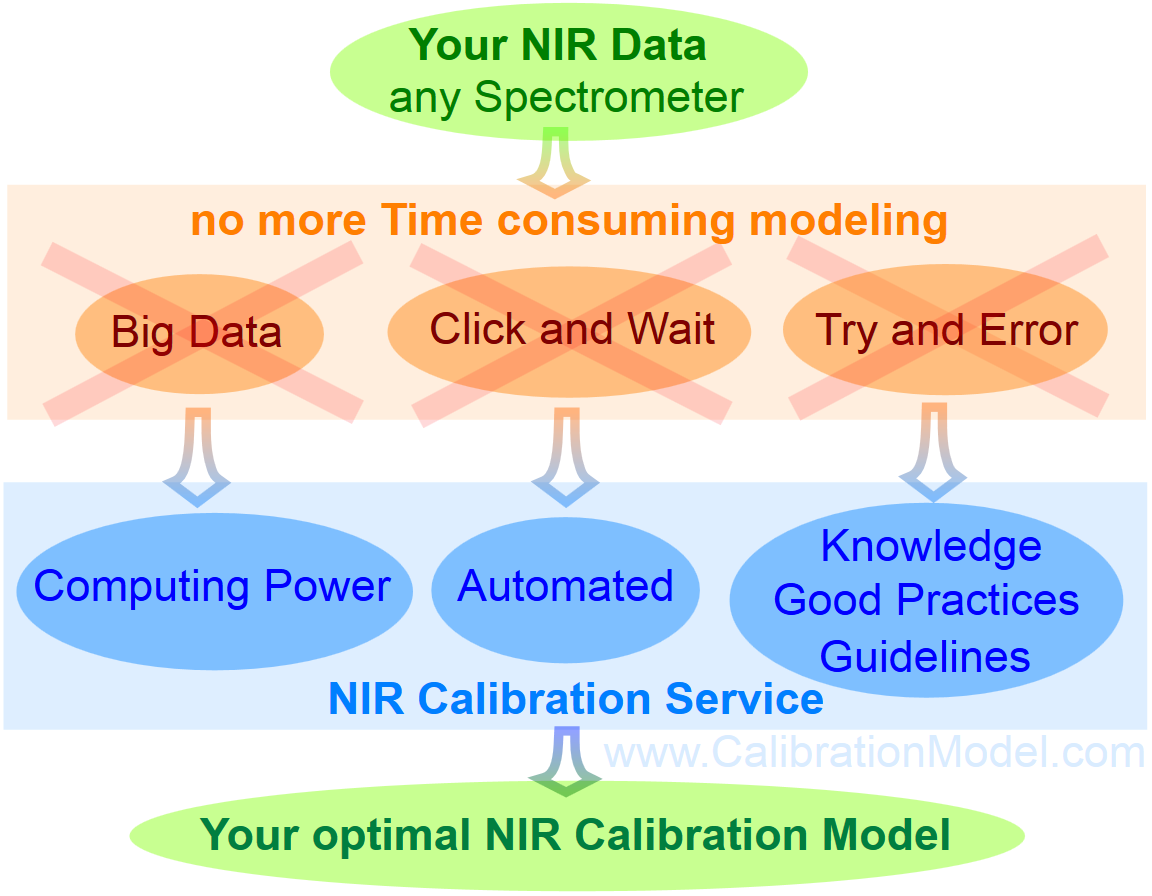New : free NIR-Predictor Software for all NIR instrument types! Analyze your samples.
Services and software for data analysis and analytical modeling for spectroscopy.
This NIR calibration service provides the custom development of optimal quantitative NIR calibration models based on your collected NIR and reference data for vendor independent full range NIR spectrometer analyzers (NIR = Near Infra Red spectroscopy) based on chemometric multivariate methods like Partial Least Square Regression (PLS, PLSR) and Principal Component Regression (PCR).
The key points
The NIR calibration model is decisive for the analysis accuracy.
NIR analysis results make the difference.

The problems
Imagine how many publications and literature of NIR spectroscopy (JNIRS) and chemometrics (Journal of Chemometrics) is present.
Did you find the time for the right to designate to read, to study, to incorporate them into practice?
Do you have all this knowledge at your calibration developments always present, that you consider anything important, the statistical results, interpret them correctly, analyze the graphs accurately and apply all the tips & tricks of optimizing correctly?
We have the solution for you!
We'll help you to create and optimize your calibrations.
We will help you for the time-consuming and knowledge-intensive part.
You get the best calibration solution and decide for yourself
Try it and see for yourself
New : free NIR-Predictor Software for all NIR instrument types! Analyze your samples.
Dienstleistungen und Software für die Datenanalyse und analytische Modellierung für die Spektroskopie.
Dieser NIR Kalibrations Service bietet die kundenspezifische Entwicklung von optimalen quantitativen NIR-Kalibrierungs Modellen für Ihre gesammelten NIR und Referenzdaten für herstellerunabhängige full-range NIR-Spektrometer Analysatoren an (NIR = Nah InfraRot-Spektroskopie) basierend auf chemometrischen multivariaten Methoden wie Partial Least Square Regression (PLS, PLSR) und Principal Component Regression (PCR).
Die Kernpunkte
Das NIR Kalibrations Modell ist entscheidend für die Analysen Genauigkeit.
NIR-Analysen Ergebnisse machen den Unterschied.

Die Probleme
Stellen Sie sich vor, wie viele Publikationen und Literatur zum Thema NIR (JNIRS) und Chemometrie (Journal of Chemometrics) vorhanden ist.
Haben Sie die Zeit, die für Sie die passende zu finden, zu bestellen, zu lesen, zu studieren, in die Praxis einfließen zu lassen?
Haben Sie dieses ganze Knowhow bei Ihren Kalibrations-Entwicklungen immer präsent, dass Sie alles wichtige Berücksichtigen, die statistischen Ergebnisse richtig deuten, die Grafiken genau analysieren und alle Tips & Tricks und Regeln der Kunst des Optimierens korrekt anwenden?
Wir haben die Lösung für Sie!
Wir helfen Ihnen, Ihre Kalibrationen zu erstellen und zu optimieren.
Wir helfen Ihnen für den zeitaufwendigen und Knowhow Intensiven Teil.
Sie erhalten die optimale Kalibrations Lösung und entscheiden selbst.
Probieren Sie es aus und sehen Sie selbst.
New : free NIR-Predictor Software for all NIR instrument types! Analyze your samples.
Servizi e software per l'analisi dei dati e la modellazione analitica per spettroscopia.
Il servizio di calibrazione NIR fornisce lo sviluppo personalizzato di modelli quantitativi di calibrazione NIR ottimizzati in base alla banca dati NIR presente nei vostri data base e con ulteriori dati di riferimento di fornitori indipendenti di spettrofotometri NIR (NIR = spettroscopia nel vicino infrarosso) sulla base di metodi chemiometrici multivariati come la funzione di regressione Least Square (PLS, PLSR) e delle Componenti Principali (PCR).
Il modello di calibrazione NIR è determinante per l'accuratezza dell'analisi. Sono i risultati delle analisi NIR a fare la differenza.
Immaginate quante pubblicazioni e letteratura sulla spettroscopia NIR (JNIRS) e persone che si occupano di chemiometria (Journal of Chemiometrics) siano presenti.
Non avete il tempo per leggere, studiare e far pratica su questo?
Avete tutta questa conoscenza a portata di mano per avere sviluppi di calibrazione sempre aggiornati da esperti; Cosa credete sia più importante: i risultati statistici, interpretarli correttamente, analizzare i grafici accuratamente e applicare tutti i consigli e i trucchi per ottimizzare correttamente i metodi di calibrazione?
Noi abbiamo la soluzione per voi!
Vi aiuteremo a creare e ottimizzare le tarature.
È possibile ottenere la migliore soluzione di calibrazione per Voi. Prova e vedere di persona


